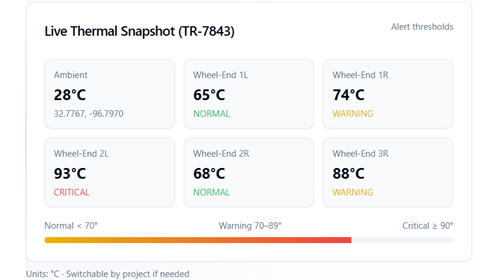
/
October 18, 2024
/
#
Min Read
Transforming Vehicle Maintenance with AI-Driven Diagnostics
AI’s capacity to drive efficiency and productivity in our daily lives is well established, but its full potential in industries like automotive is just beginning to unfold. One key area where AI can deliver transformative value is in vehicle maintenance and service management. Traditional diagnostic systems, still largely reliant on reactive processes and manual troubleshooting, are simply not equipped to handle the complexity of modern software-defined vehicles. This is where AI offers the ability to provide faster, more precise diagnostics, drastically reducing downtime while improving vehicle health.
Enter AI-Driven Diagnostics - an advanced, data-driven approach set to redefine how OEMs approach diagnostics, fault management, and service operations. Let’s dive deeper into the specific ways AI-driven diagnostics address long-standing issues and the underlying technologies that enable these innovations.
The Limitations of Traditional Vehicle Diagnostics
Delayed Fault Detection Through Reactive Systems
Traditional diagnostic systems typically operate in a reactive manner, where fault detection occurs after the fact—often through on-board diagnostic (OBD) systems that trigger alerts only when a problem has already escalated. This method is inadequate in the context of modern vehicle architectures, which contain hundreds of interconnected ECUs (Electronic Control Units) communicating over complex in-vehicle networks like CAN (Controller Area Network), FlexRay, or Ethernet.
The issue with reactive detection is the lag between the occurrence of an anomaly and its eventual identification, leading to:
- Escalating warranty claim costs as undetected minor issues grow into major component failures.
- Loss of customer confidence due to repeated or extended vehicle downtime.
- Higher total cost of ownership for fleets as breakdowns disrupt operations.
Complexity of Fault Isolation in Interconnected Systems
The growing number of sensors, ECUs, and in-vehicle software has led to diagnostic complexity far beyond what traditional methods can manage effectively. For example, a fault in a subsystem such as a camera module might be a result of software misconfigurations, wiring faults, or corrupted data packets transmitted over the CAN bus. Diagnosing such issues often requires cross-referencing multiple fault codes (DTCs) and running extensive system-wide checks.
The impact of this complexity includes:
- Extended troubleshooting times, as technicians sift through error logs, system architectures, and technical manuals.
- Inconsistent diagnostic accuracy, as human interpretation of fault codes can vary from one service center to another.
- Rising training requirements for service technicians, who must familiarize themselves with a growing number of systems and vehicle configurations.
How AI-Driven Diagnostics Overcome These Challenges
Proactive Fault Detection via Continuous Data Monitoring
AI-driven diagnostics work in tandem with real-time data collection platforms like Deep Logger. By continuously streaming vehicle data—engine metrics, sensor outputs, communication bus signals, and other telemetry - AI models can detect anomalies long before they develop into noticeable faults. This capability hinges on machine learning algorithms trained on historical vehicle performance data and OEM-specific fault patterns.
For instance, using predictive analytics, an AI system can correlate fluctuations in sensor outputs with the early stages of brake wear or battery degradation. Rather than waiting for an OBD fault code, the system proactively flags the anomaly, giving technicians a chance to intervene early.
Key benefits include:
- Reduced warranty claim costs: Proactive identification of issues allows OEMs to perform less costly repairs earlier, often avoiding major component replacements.
- Higher customer satisfaction: Vehicles remain operational for longer periods, with fewer unexpected breakdowns.
- Improved uptime for fleets: For commercial operators, reducing downtime translates directly into higher revenue and operational efficiency.
Real World Example:
A technician resolves a backup camera calibration issue remotely using AI diagnostics:
Machine Learning-Powered Fault Isolation
Once an anomaly is detected, AI-driven diagnostics employ machine learning models capable of narrowing down potential fault sources with high accuracy. By analyzing the interdependencies of various ECUs and subsystems, the AI can pinpoint the most likely cause of the fault. For example, if a vehicle reports multiple seemingly unrelated DTCs (Diagnostic Trouble Codes), the system might trace the issue to a malfunctioning power supply module affecting multiple ECUs at once.
This offers several advantages:
- Faster root cause identification: By eliminating unnecessary checks, the AI system accelerates the troubleshooting process.
- Cross-system diagnostics: AI can identify relationships between subsystems (e.g., a fault in an engine sensor that impacts transmission behavior), which traditional diagnostics might miss.
- Consistency across service centers: Machine learning-based diagnostic systems offer standardized outputs, ensuring all technicians follow the same fault isolation process.
AI-Powered Diagnostic Assistance for Technicians
One of the most compelling features of AI-driven diagnostics is the AI Diagnostic Assistant, which bridges the gap between vehicle data and technician expertise. This assistant, powered by natural language processing (NLP) and deep learning, interacts directly with technicians, providing real-time troubleshooting guidance. By analyzing a combination of historical repair data, technical manuals, and telemetry, it can offer actionable steps to resolve even complex issues.
For example, a technician can receive an alert that a vehicle’s ADAS (Advanced Driver Assistance System) isn’t calibrating correctly. The AI assistant analyzes diagnostic logs and identifies that the issue stems from a sensor misalignment. It then walks the technician through the recalibration process, which can be done remotely via the vehicle’s software interface.
Advantages include:
- Standardized troubleshooting protocols: AI assists technicians in following OEM-approved workflows, reducing human error.
- Faster resolution times: AI systems use historical data to predict the best course of action, reducing trial and error.
- Lower training costs: New technicians can leverage AI-assisted troubleshooting to become proficient more quickly.
AI Diagnostics and Control with Remote Updates & Commands
Another key innovation enabled by AI diagnostics is the integration of remote software management tools like Deep Updater and Deep Commander. These tools enable technicians and OEMs to perform remote diagnostics, push software updates, and execute system commands over-the-air (OTA), further reducing vehicle downtime.
Deep Updater:
This tool allows for OTA software updates, including bug fixes, performance enhancements, and security patches. When an AI system identifies a software-related issue, Deep Updater can automatically push an update to affected vehicles, reducing the need for physical service visits.
Deep Commander:
Technicians can execute remote commands such as system resets, module reboots, or recalibrations via Deep Commander. For example, if a fault is detected in the steering system’s ECU, the technician can initiate a remote recalibration directly through the system.
Real World Example:
A technician remotely diagnoses and updates the HVAC software via Deep Updater:
Unlocking New Opportunities with AI-Driven Diagnostics
Predictive Maintenance and Data Monetization
AI-driven diagnostics enable predictive maintenance models where OEMs can offer value-added services based on real-time data analytics. By providing early warnings of component wear or system degradation, OEMs can offer premium services, such as maintenance subscriptions for fleet operators, reducing the likelihood of expensive breakdowns.
Enhanced Service Offerings for OEMs
OEMs can use AI-driven diagnostics to create new service contracts, guaranteeing minimal downtime and rapid repairs. These offerings are particularly attractive to fleet operators, who rely on vehicle uptime for revenue generation.
Competitive Edge Through Proactive Diagnostics
As AI-driven diagnostics become a staple in connected vehicle ecosystems, OEMs adopting this technology gain a significant competitive advantage. The ability to predict and resolve faults remotely not only enhances the customer experience but also positions OEMs as leaders in cutting-edge vehicle technology.
Conclusion: The AI-Driven Future of Vehicle Maintenance
AI-driven diagnostics are the future of vehicle maintenance, providing OEMs with the tools to transition from reactive to proactive service models. With continuous data monitoring, predictive analytics, and remote capabilities, AI diagnostics minimize downtime, reduce costs, and enable new business models. The future of vehicle maintenance isn’t just smarter - it’s proactive, data-driven, and designed to keep fleets moving efficiently.






-min.png)



